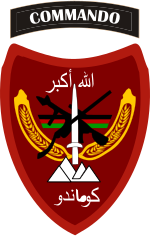The Military history of Afghanistan began before 1709 when the Hotaki dynasty was established in Kandahar followed by the Durrani Empire. The Afghan military was re-organized with assistance from the British in 1880, when the country was ruled by Amir Abdur Rahman Khan. It was modernized during King Amanullah Khan's rule in the early 20th century, and then during King Zahir Shah's forty-year rule; the Soviet Union supplied almost all weapons, training and military needs between the 1950s and 1970s. From 1978 to 1992, the Soviet-backed Afghan Armed Forces engaged in heavy fighting with the multi-national mujahideen groups who were then backed by the United States, Pakistan and others. After President Najibullah's resignation in 1992 and the end of Soviet support, the Afghan military dissolved into portions controlled by different factions. This era was followed by the Taliban regime, whose leaders were trained and influenced by the Pakistan Armed Forces.

The International Security Assistance Force (ISAF) was a multinational military mission in Afghanistan from 2001 to 2014. It was established by United Nations Security Council Resolution 1386 pursuant to the Bonn Agreement, which outlined the establishment of a permanent Afghan government following the U.S. invasion in October 2001. ISAF's primary goal was to train the Afghan National Security Forces (ANSF) and assist Afghanistan in rebuilding key government institutions; it gradually took part in the broader war in Afghanistan against the Taliban insurgency.

The Islamic National Army, also referred to as the Islamic Emirate Army and the Afghan Army, is the land force branch of the Afghan Armed Forces. The roots of an army in Afghanistan can be traced back to the early 18th century when the Hotak dynasty was established in Kandahar followed by Ahmad Shah Durrani's rise to power. It was reorganized in 1880 during Emir Abdur Rahman Khan's reign. Afghanistan remained neutral during the First and Second World Wars. From the 1960s to the early 1990s, the Afghan Army was equipped by the Soviet Union.

Embedded Training Teams or ETT is the term used by the US military since 2003 to describe conventional forces used to train and mentor Afghan forces. They were formed in 2003 under Task Force Phoenix. Although ETT refers to the Embedded Training "Team", members of the team itself commonly refer to themselves as "ETTs"

The National Military Academy of Afghanistan (NMAA) was one of three academic institutions of the Marshal Fahim National Defense University. It was a four-year military development institution dedicated to commissioning officers for the Afghan National Army (ANA) and the Afghan Air Force (AAF). The mission of the NMAA was to produce officers for the Afghan Armed Forces that also have a four-year college level bachelor's degree. The academy was based upon the United States Military Academy and United States Air Force Academy. After the fall of the Islamic Republic of Afghanistan on August 15, 2021, to the Taliban, and the simultaneous collapse of the Afghan National Army and Afghan Air Force the same day, the Academy was officially shut down.

Camp Shorabak is a former British Army airbase, located northwest of the city of Lashkargah in Helmand Province, Afghanistan. The camp was situated in a remote desert area, far from population centres.

US and NATO International Security Assistance Force (ISAF) operations, alongside Afghan National Army forces, continued against the Taliban through 2007.
United States and NATO International Security Assistance Force (ISAF) operations, alongside Afghan National Army forces, continued against the Taliban through 2008.

Task Force Phoenix, or more properly known as Combined Joint Task Force Phoenix, was an international military formation. It was organized by the United States Central Command (CENTCOM) in 2003-2004 to train and mentor the newly created Afghan National Army/Afghan National Security Forces (ANSF) to establish and maintain law and order throughout Afghanistan using Embedded Training Teams or ETTs.

The 205th 'Atul' (Hero) Corps was a corps-level formation of the Afghan National Army. Its headquarter were located in Kandahar and it was responsible for the south of the country, partnered with the ISAF's Regional Command South.
The NATO Training Mission-Afghanistan (NTM-A) was a multinational military organisation, activated in November 2009, tasked with providing a higher-level training for the Afghan National Army (ANA) and Afghan Air Force (AAF), including defense colleges and academies, as well as being responsible for doctrine development, and training and advising Afghan National Police (ANP). The commanding officer was dual-hatted and commanded both NTM-A and Combined Security Transition Command – Afghanistan (CSTC-A) and reported to the Commander of ISAF.
Operation Moshtarak, also known as the Battle of Marjah, was an International Security Assistance Force (ISAF) pacification offensive in the town of Marjah, Helmand Province, Afghanistan. It involved a combined total of 15,000 Afghan, American, British, Canadian, Danish, and Estonian troops, constituting the largest joint operation of the War in Afghanistan up to that point. The purpose of the operation was to remove the Taliban from Marja, thus eliminating the last Taliban stronghold in central Helmand Province. The main target of the offensive was the town of Marjah, which had been controlled for years by the Taliban as well as drug traffickers.
Operation Dragon Strike was a NATO counter-insurgent mission in Kandahar province, Afghanistan, against Taliban forces, which started on September 15, 2010.
Brigadier General Mohammed Zafar Khan is a commander of the Afghan National Army stationed in Uruzgan, Afghanistan. He was appointed for the post of commander of the 4th Brigade, 205th Corps on 11 September 2010.

The 207th 'Zafar' (Victory) Corps was a corps of the Afghan National Army. It was headquartered at Camp Zafar, Herat, in Herat Province in the west of Afghanistan.

The Afghan National Army Special Operations Command is a special forces formation of the Afghan National Army, established in 2011.

The Afghan Armed Forces, officially the Armed Forces of the Islamic Emirate of Afghanistan, also referred to as the Islamic Emirate Armed Forces, is the military of Afghanistan, commanded by the Taliban government from 1997 to 2001 and since August 2021. According to Afghanistan's Ministry of Defense, its total manpower is 170,000 as of September 2023.

The Badri 313 Battalion is a unit of the Taliban. The unit's name is closely associated with the Haqqani network, which has reportedly provided them with training. Elite Taliban units like the Badri 313 have been reported as being "critical in the taking over of Afghanistan". In July and August 2021, the Taliban released online video on the Badri 313 Battalion in various local languages, English and Arabic.

After the formation of the Karzai administration in late 2001, the Afghan Armed Forces were gradually reestablished by the United States and its allies.
The 201 Khalid Ibn Walid Corps is one of the eight corps of the Islamic Emirate Army established in October 2021 and headquartered in Laghman. The current Chief of Staff is Abdul Rahman Mansoori.













